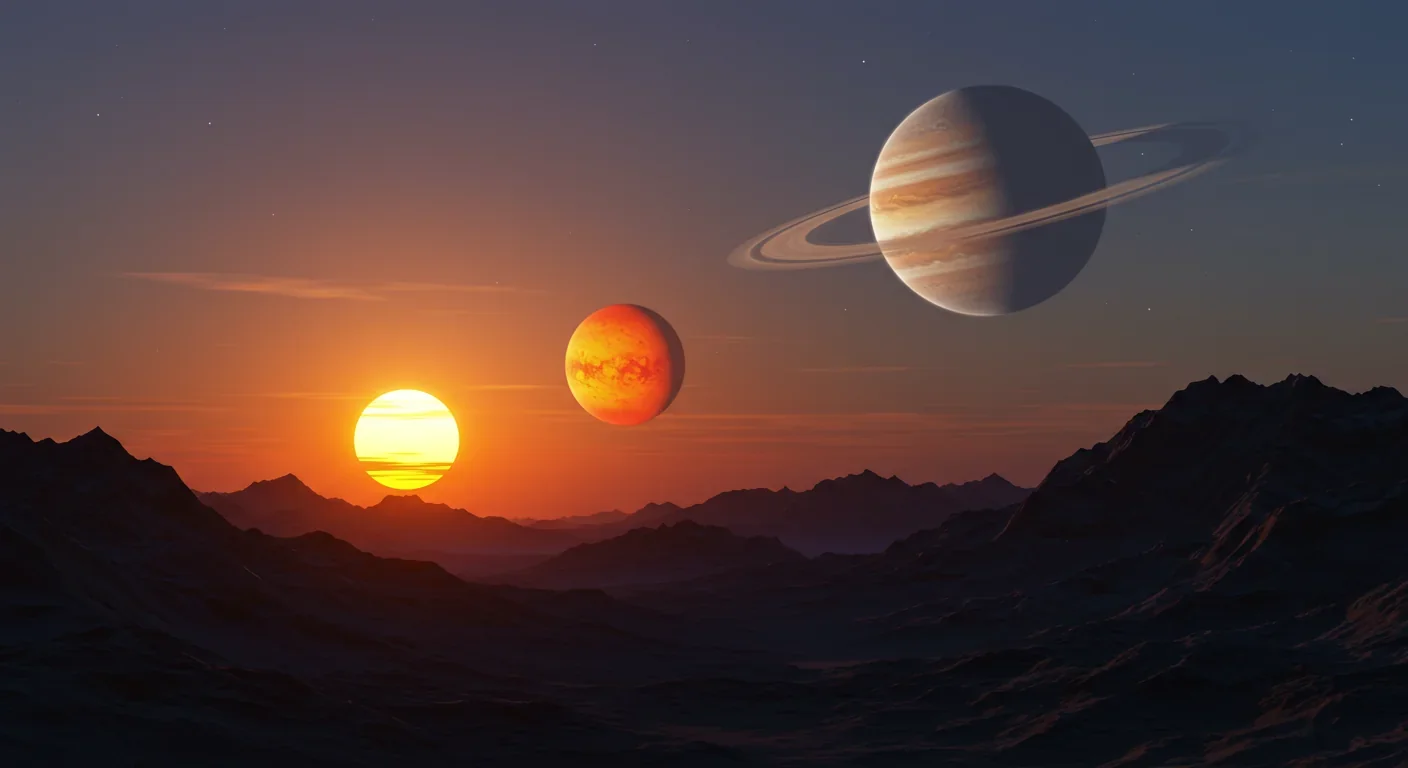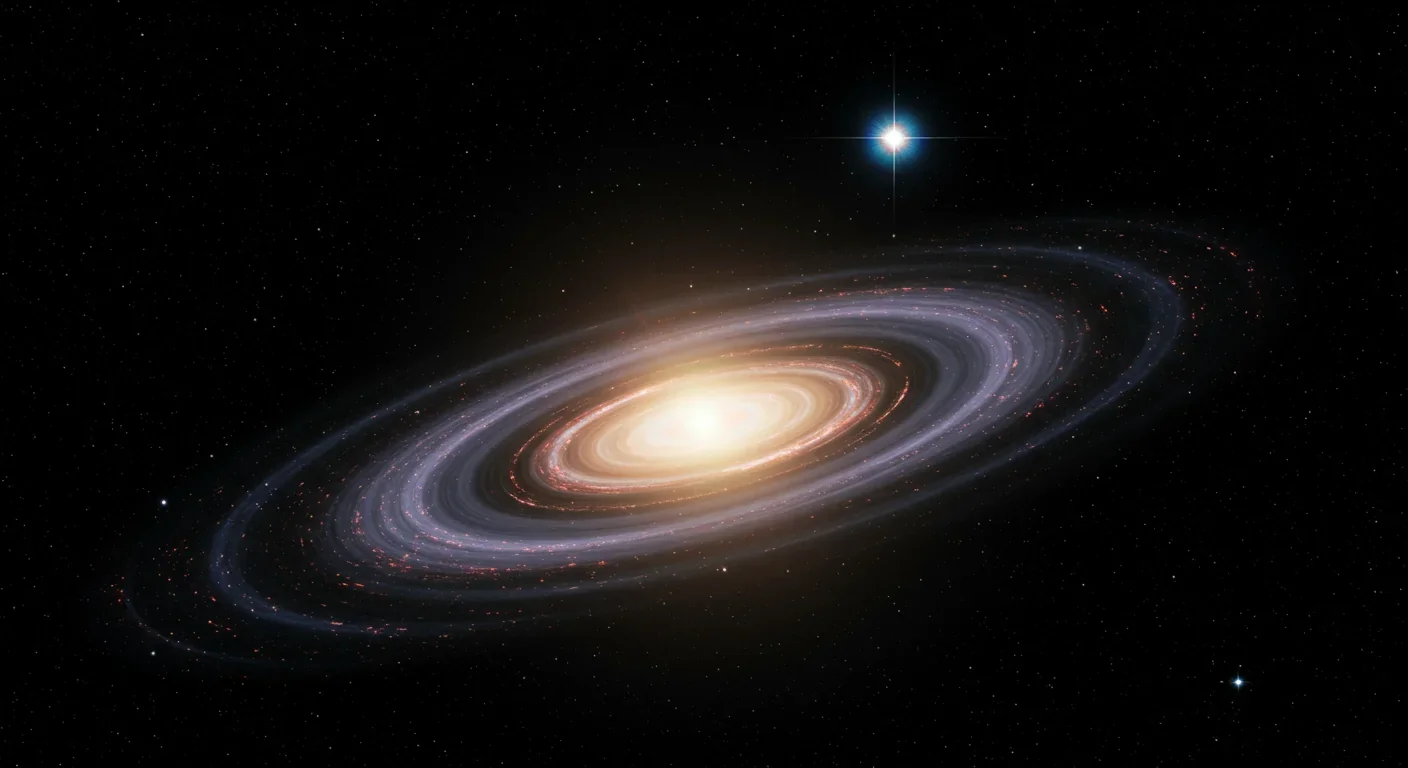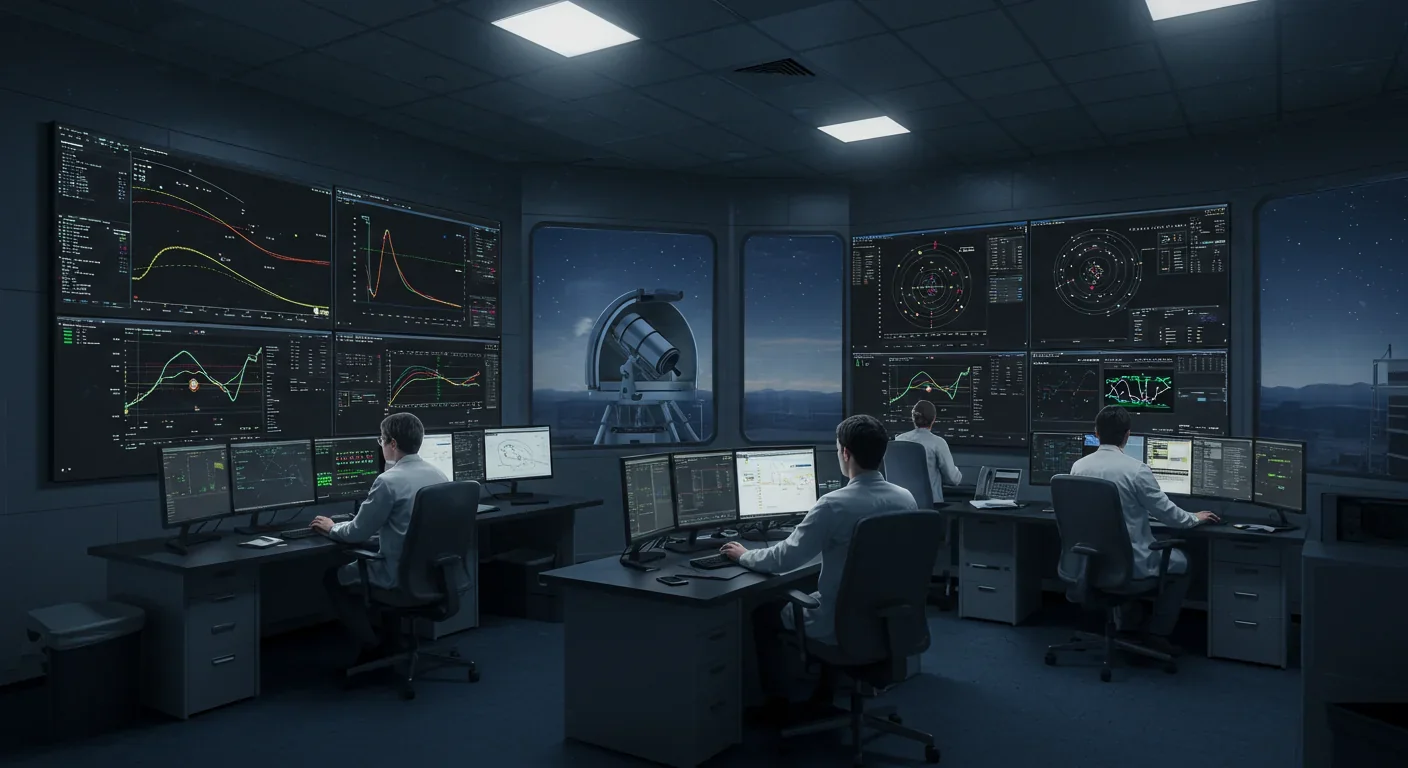Fusion Rockets Could Reach 10% Light Speed: The Breakthrough

TL;DR: Binary star systems, home to over half the galaxy's stars, present unique challenges for planetary habitability through variable radiation and complex gravitational dynamics, yet astronomers are discovering dozens of circumbinary planets and exploring whether life could adapt to these chaotic dual-sun environments.

Picture a sunset on a planet where two suns sink below the horizon in tandem, painting the sky in overlapping gradients of amber and crimson. It's the kind of scene that made Star Wars iconic, but today it's not just science fiction. We've found real planets orbiting two stars at once, and scientists are racing to figure out whether such worlds could harbor life.
More than half the stars in our galaxy belong to binary or multiple star systems. That means billions of potential planets might be bathed in the light of two suns instead of one. The question isn't whether these planets exist anymore—we've confirmed dozens of them. The question is whether the wild, chaotic environments they inhabit could ever allow life to gain a foothold.
Before we can talk about habitability, we need to understand what a binary star system actually is. In the simplest terms, it's a pair of stars locked in a gravitational embrace, orbiting their common center of mass. Some binaries are tight, with the stars whipping around each other in just a few days. Others are wide, separated by distances larger than our entire solar system.
The orbital dynamics get complicated fast. Unlike our solar system, where planets orbit a single, stable point of light, planets in binary systems face a constantly shifting gravitational landscape. Close binaries can disrupt planet formation entirely, while wide binaries might be relatively benign. It all depends on the separation between the stars and the planet's orbital configuration.
There are two main types of planetary orbits in binary systems: circumbinary orbits, where a planet circles both stars from afar, and circumstellar orbits, where a planet hugs close to just one star while the companion lurks in the distance. Each configuration presents its own challenges for climate stability and habitability.
Imagine trying to predict the weather when your planet receives energy from two independent furnaces, each with its own brightness, color, and variability. That's the reality for any world orbiting a binary star. The radiation environment is inherently more complex than Earth's, and that complexity ripples through every aspect of a planet's climate.
For circumbinary planets like TOI-1338b—discovered by a NASA intern on his third day—the total energy input varies as the stars eclipse and amplify each other over the course of their orbit. When both stars are visible, the planet bakes. When one star hides behind the other, the light dims. These fluctuations happen on timescales much shorter than a planet's year, creating a pulsing rhythm of warmth and cold that has no analog in our solar system.
The habitable zone itself becomes a moving target. In a single-star system, the habitable zone is a nice, stable ring where liquid water can exist. In a binary system, that zone shifts and wobbles as the stars move. A planet that starts out in the Goldilocks region might drift in and out of habitability over the course of a single binary orbit.
Tidal perturbations from the central binary can also limit dust grain growth in the surrounding disk, potentially stalling planet formation before habitable worlds even get a chance to coalesce. In the young triple system V892 Tau, dust grains grow only to a few millimeters before fragmenting, likely because of the gravitational chaos stirred up by the binary. Fewer building blocks means fewer chances for rocky, Earth-like planets to form.
We've moved beyond speculation. Thanks to missions like NASA's TESS and the Kepler Space Telescope, we've confirmed dozens of circumbinary planets and are finding more all the time. These discoveries are rewriting our assumptions about where planets can form and what kinds of environments they might endure.
Take TOI-1338b, the planet discovered by 17-year-old Wolf Cukier while interning at NASA. It's a Neptune-sized world orbiting two stars in the constellation Pictor, one about 10% more massive than the Sun and the other a cool red dwarf. The planet completes its circumbinary orbit every 95 days, experiencing a constantly shifting blend of stellar radiation as the two stars wheel around each other every 15 days.
Then there's Kepler-16b, the first confirmed circumbinary planet. It's a gas giant roughly the size of Saturn, orbiting two stars every 229 days. The stars themselves orbit each other every 41 days, creating a complex dance of shadows and light. The planet sits right on the inner edge of the habitable zone, though its frigid, gaseous nature means it's not a candidate for life itself. Still, if it had a rocky moon with a thick atmosphere, that moon could be a different story.
More intriguing is Proxima Centauri b, a planet orbiting the red dwarf Proxima Centauri, which is itself part of a triple-star system with Alpha Centauri A and B. Proxima b sits squarely in the habitable zone and receives about 70% of the infrared energy Earth gets from the Sun. But there's a catch: Proxima Centauri is a flare star with intense electromagnetic radiation that could strip away a planet's atmosphere over time. The dynamics of the larger Alpha Centauri system may have caused Proxima b to migrate inward over its history, potentially altering its atmospheric retention.
Recently, astronomers directly imaged HD 143811 AB b, a giant planet orbiting a spectroscopic binary in the Sco-Cen association. Unlike transit detections, direct imaging lets us study the planet's atmosphere and composition in detail, opening new windows into how these worlds form and evolve.

Suppose a planet in a binary system manages to hold onto its atmosphere and maintain liquid water. Could life actually emerge and survive there? The answer depends on how well biology can cope with extreme variability.
On Earth, life thrives in astonishingly harsh environments—hydrothermal vents, Antarctic ice, acidic hot springs. Extremophiles have taught us that life is resilient, adaptable, and opportunistic. But Earth's climate, for all its ice ages and volcanic winters, is fundamentally stable compared to what a binary planet might experience.
The biggest challenge is radiation variability. If a planet's stellar heating fluctuates dramatically on timescales of days to weeks, any life there would need to handle rapid temperature swings. Organisms might hibernate during dim phases and accelerate metabolism during bright ones, or evolve thick insulation and thermal buffering mechanisms. Photosynthetic life would face erratic light levels, potentially favoring organisms that can store energy or switch metabolic pathways on the fly.
Tidal locking is another issue. Proxima Centauri b is likely tidally locked, meaning one side always faces the star. In a binary system, tidal forces are even more complex. A planet could end up locked in a resonance with one or both stars, creating extreme temperature gradients between day and night sides. Life might only be possible in the twilight zone between eternal daylight and eternal darkness.
Then there's the threat of stellar flares and coronal mass ejections. Red dwarfs, which are common companions in binary systems, are notorious for violent outbursts. A planet orbiting a flare star would be bombarded with high-energy particles and radiation, potentially eroding its atmosphere and sterilizing its surface. Atmospheric loss from intense stellar activity is a serious barrier to habitability, especially for planets close to active stars.
Still, life might find a way. Subsurface oceans, shielded by kilometers of ice, could protect microbes from radiation. Magnetic fields, if strong enough, could deflect stellar wind and preserve the atmosphere. And if photosynthesis proves too difficult, chemosynthetic organisms—like those around Earth's deep-sea vents—could harness chemical energy instead of light.
Detecting life on an exoplanet is hard enough around a single star. Around a binary, it gets even trickier. The constantly changing stellar background makes it difficult to isolate a planet's atmospheric signal from the noise of its parent stars.
A biosignature must dominate over all other processes that could produce similar spectral features. In a binary system, that bar is higher. Stellar variability can mimic biological signals, and the complex radiation environment can create false positives. For example, oxygen might accumulate in an atmosphere through photodissociation of water vapor rather than biological activity, especially if stellar UV flux is high and variable.
The best strategy is to look for combinations of gases in thermochemical disequilibrium. Oxygen and methane together are a classic example: on Earth, this mix is maintained only by life, because methane and oxygen react to destroy each other unless constantly replenished. Finding such a signature in a binary planet's atmosphere would be compelling evidence for biology.
Recent observations are encouraging. In 2023, NASA announced that the James Webb Space Telescope detected possible dimethyl sulfide on exoplanet K2-18b—a gas that on Earth is only produced by life. While K2-18b orbits a single star, the detection demonstrates that we now have the tools to identify biosignature gases in exoplanet atmospheres. Applying these techniques to binary systems is the next frontier.
The next generation of telescopes and missions will transform our understanding of binary star habitability. The James Webb Space Telescope is already characterizing exoplanet atmospheres with unprecedented precision. The European Space Agency's PLATO mission, scheduled to launch in 2026, will search for rocky planets in the habitable zones of binary systems.
Ground-based observatories like the Extremely Large Telescope (ELT) and the Thirty Meter Telescope (TMT) will directly image planets around nearby binaries, measuring their temperatures, atmospheric compositions, and surface conditions. These observations will let us test theoretical models of binary planet climates against real data.
We also need better climate models. Current simulations of circumbinary planets are just beginning to capture the full complexity of dual-star heating, atmospheric dynamics, and ocean circulation. The Kozai mechanism, a gravitational effect that can pump up a planet's orbital eccentricity over time, could drive extreme seasonal variations that models must account for.
One exciting area of research is gas and dust dynamics in binary disks. Understanding how planets form in these chaotic environments will tell us which kinds of binary systems are most likely to produce habitable worlds—and which are dead ends.

The discovery that life could thrive around binary stars would fundamentally expand the real estate available for biology in the universe. If half the stars in the galaxy are in binary or multiple systems, and even a fraction of those can host habitable planets, the odds of finding life elsewhere skyrocket.
It also forces us to rethink our assumptions about what "habitable" really means. For decades, we've defined habitability based on Earth-like conditions: a single, stable star, a rocky planet with liquid water, a protective atmosphere. But the universe might be far more creative. Life could flourish in environments we'd never consider hospitable—under fluctuating radiation, in resonant orbits, on moons of gas giants bathed in the light of two suns.
This research has practical implications for the search for extraterrestrial intelligence (SETI). If civilizations can arise on binary star planets, our radio surveys should target these systems too. Any signals from such worlds might reveal civilizations that evolved under radically different environmental pressures, with technologies and cultures shaped by the unique rhythms of a double sunset.
We're living through a golden age of exoplanet discovery. Every few weeks, new worlds are confirmed, new techniques are refined, and our understanding of planetary habitability deepens. Binary star systems, once considered too chaotic for life, are now prime targets in the search for habitable worlds.
The challenges are real: variable radiation, complex gravitational dynamics, atmospheric erosion, and tidal extremes. But so is the potential. Life on Earth has survived mass extinctions, ice ages, and asteroid impacts. It's adapted to extreme heat, extreme cold, and extreme chemistry. If biology can handle that, maybe it can handle two suns.
As we build more powerful telescopes and refine our models, we'll learn whether the twin sunsets of Tatooine are just fantasy—or a glimpse of countless real worlds scattered across the galaxy, waiting to be discovered. And if we do find life on a planet orbiting two stars, it will be a reminder that the universe is not only stranger than we imagine, but stranger than we can imagine.
The next time you watch a double sunset in a science fiction movie, remember: somewhere out there, it might be happening for real. And something might be watching.

Recent breakthroughs in fusion technology—including 351,000-gauss magnetic fields, AI-driven plasma diagnostics, and net energy gain at the National Ignition Facility—are transforming fusion propulsion from science fiction to engineering frontier. Scientists now have a realistic pathway to accelerate spacecraft to 10% of light speed, enabling a 43-year journey to Alpha Centauri. While challenges remain in miniaturization, neutron management, and sustained operation, the physics barriers have ...

Epigenetic clocks measure DNA methylation patterns to calculate biological age, which predicts disease risk up to 30 years before symptoms appear. Landmark studies show that accelerated epigenetic aging forecasts cardiovascular disease, diabetes, and neurodegeneration with remarkable accuracy. Lifestyle interventions—Mediterranean diet, structured exercise, quality sleep, stress management—can measurably reverse biological aging, reducing epigenetic age by 1-2 years within months. Commercial ...

Data centers consumed 415 terawatt-hours of electricity in 2024 and will nearly double that by 2030, driven by AI's insatiable energy appetite. Despite tech giants' renewable pledges, actual emissions are up to 662% higher than reported due to accounting loopholes. A digital pollution tax—similar to Europe's carbon border tariff—could finally force the industry to invest in efficiency technologies like liquid cooling, waste heat recovery, and time-matched renewable power, transforming volunta...

Humans are hardwired to see invisible agents—gods, ghosts, conspiracies—thanks to the Hyperactive Agency Detection Device (HADD), an evolutionary survival mechanism that favored false alarms over fatal misses. This cognitive bias, rooted in brain regions like the temporoparietal junction and medial prefrontal cortex, generates religious beliefs, animistic worldviews, and conspiracy theories across all cultures. Understanding HADD doesn't eliminate belief, but it helps us recognize when our pa...

The bombardier beetle has perfected a chemical defense system that human engineers are still trying to replicate: a two-chamber micro-combustion engine that mixes hydroquinone and hydrogen peroxide to create explosive 100°C sprays at up to 500 pulses per second, aimed with 270-degree precision. This tiny insect's biochemical marvel is inspiring revolutionary technologies in aerospace propulsion, pharmaceutical delivery, and fire suppression. By 2030, beetle-inspired systems could position sat...

The U.S. faces a catastrophic care worker shortage driven by poverty-level wages, overwhelming burnout, and systemic undervaluation. With 99% of nursing homes hiring and 9.7 million openings projected by 2034, the crisis threatens patient safety, family stability, and economic productivity. Evidence-based solutions—wage reforms, streamlined training, technology integration, and policy enforcement—exist and work, but require sustained political will and cultural recognition that caregiving is ...

Every major AI model was trained on copyrighted text scraped without permission, triggering billion-dollar lawsuits and forcing a reckoning between innovation and creator rights. The future depends on finding balance between transformative AI development and fair compensation for the people whose work fuels it.